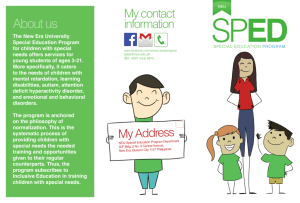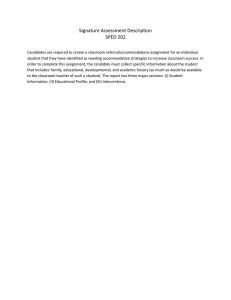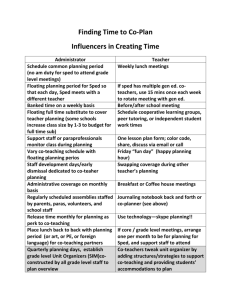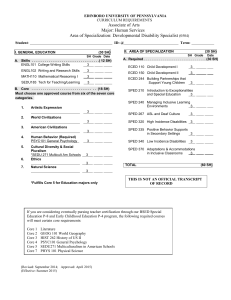SOUTHWOOD ELEMENTARY School Improvement Plan 2014-15
advertisement
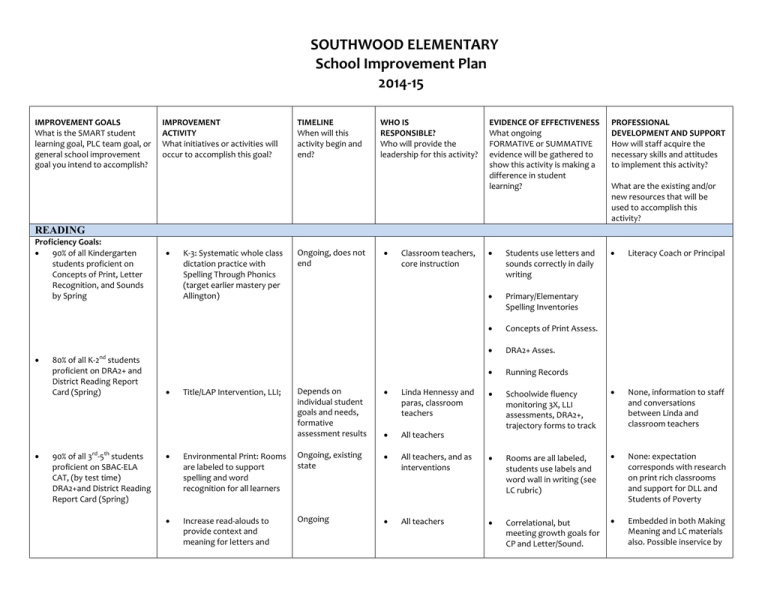
SOUTHWOOD ELEMENTARY School Improvement Plan 2014-15 IMPROVEMENT GOALS What is the SMART student learning goal, PLC team goal, or general school improvement goal you intend to accomplish? IMPROVEMENT ACTIVITY What initiatives or activities will occur to accomplish this goal? TIMELINE When will this activity begin and end? WHO IS RESPONSIBLE? Who will provide the leadership for this activity? EVIDENCE OF EFFECTIVENESS What ongoing FORMATIVE or SUMMATIVE evidence will be gathered to show this activity is making a difference in student learning? PROFESSIONAL DEVELOPMENT AND SUPPORT How will staff acquire the necessary skills and attitudes to implement this activity? Students use letters and sounds correctly in daily writing Literacy Coach or Principal Primary/Elementary Spelling Inventories Concepts of Print Assess. DRA2+ Asses. Running Records Schoolwide fluency monitoring 3X, LLI assessments, DRA2+, trajectory forms to track None, information to staff and conversations between Linda and classroom teachers What are the existing and/or new resources that will be used to accomplish this activity? READING Proficiency Goals: 90% of all Kindergarten students proficient on Concepts of Print, Letter Recognition, and Sounds by Spring 80% of all K-2nd students proficient on DRA2+ and District Reading Report Card (Spring) 90% of all 3rd-5th students proficient on SBAC-ELA CAT, (by test time) DRA2+and District Reading Report Card (Spring) K-3: Systematic whole class dictation practice with Spelling Through Phonics (target earlier mastery per Allington) Title/LAP Intervention, LLI; Ongoing, does not end Classroom teachers, core instruction Depends on individual student goals and needs, formative assessment results Linda Hennessy and paras, classroom teachers All teachers Environmental Print: Rooms are labeled to support spelling and word recognition for all learners Ongoing, existing state All teachers, and as interventions Rooms are all labeled, students use labels and word wall in writing (see LC rubric) None: expectation corresponds with research on print rich classrooms and support for DLL and Students of Poverty Increase read-alouds to provide context and meaning for letters and Ongoing All teachers Correlational, but meeting growth goals for CP and Letter/Sound. Embedded in both Making Meaning and LC materials also. Possible inservice by 90% of all students K-5 Independent or Advanced in Reading Engagement on the DRA2+ sounds, and to provide background knowledge and vocabulary Teacher survey on # read alouds Linda Hennessy or Lynn Lofstrom as needed Integrate read-alouds throughout content areas to strengthen background knowledge and build vocabulary Ongoing Classroom Teachers Student confidence and engagement in content concepts and skills, use of content vocabulary in student work, writing about reading, student conversations in conferring and in-class activities Making Meaning, Comp Toolkit alternate texts, books by Laminack and Wadsworth, Staff Inservice by Linda Hennessy Systematically teach all Units and Lessons from Making Meaning; Follow Scope and Sequence Students successful on assessments aligned with released items (after they are taught and practiced) Exit slips from staff meetings, lesson plans, results from assessments brought to PLC Happened in August; additional support from Coaches as needed Use Digital Library of Released Items When released CR Teachers, SpEd Released item assessments Inservice by DL facilitators Comprehension Toolkit with new Scope and Sequence Follow scope and sequence or weave in lessons as appropriate CR Teachers, SpEd Students response sheets, students appropriately apply strategies in their reading Review? DVD in kit, Literacy Coach consult Teach Close Reading Strategies; (K-5) Summary of multiple articles (3-5) Ongoing Classroom Teachers, Title LAP teacher, SpEd teacher Student work Digital Library Facilitators Continue classroom practices in Reader’s Workshop of small group reading and one-one conferring Ongoing Students frequently assess themselves regarding their reading interests and independently select reading materials appropriate to interest and skill level Review information on Summer Reading Loss from Allington during staff meeting (reading engagement as antidote); staff share information on fostering student engagement Time study to maximize use of instructional time, eliminate practices that do not contribute to goals Oct. 15 and on Students and teachers engaged, clear purpose can be stated for all activities, student ownership of learning Staff meeting inservice, staff book study: No More Sharpening Pencils During Work Time: Not This But That series All teachers *Three Times Yearly Building Wide Fluency Measure Fall, Winter, Spring Linda Hennessy and Title/LAP paras Students increase reading rate and accuracy to grade level standard per trimester, growth measured in 3 week increments None at this time --correlated with----*Early administration of DRA2+ Reading Assessment Fall, Winter for some students Classroom Teachers Students increase reading level (comprehension, fluency) by one or two performance bands depending on results Lit Coach, peers Scheduling: Building Wide Intervention Schedule Daily Core Teachers, Sped, Title One, Paras Formative Assessments aligned with specific Interventions, Classroom work Staff Learning Meeting Oral Language Practice: Speaking and Listening Using Making Meaning and LC Units of Study, Anchor charts with stems to prompt Following Scope and Sequence Classroom Teachers, SpEd Student work and performance Systematically teach LC Units of Study for Writing, all grades Use scope and sequence Classroom Teachers, SpEd as appropriate Writing Samples scored to rubrics in LC, growth from pre-assessment to post assessment August, ongoing with Lit Support and Grade Levels WRITING Proficiency Goals: 80% of all 3rd-5th grade students proficient on SBAC-ELA Writing PPT 80% of all 2nd-5th Grade students proficient on the District Writing Assessment Use released items from Digital Library to crosswalk writing about reading When items become available Classroom Teachers, SpEd DL Item assessments, classroom work aligned with samples and scored during PLC match SBAC levels Staff Meeting(s) with DL Facilitator 80% of all K-5th grade students at Grade Level on LC Units of Study PostAssessments of the three genre: Opinion, Information, and Narrative writing Teach LC Units of Study with fidelity, all grades Ongoing now to end of year Classroom Teachers, Sped Writing Samples scored to rubrics and benchmark papers; students are at grade level August, ongoing with Lit Coaches Anchor papers from our own students

